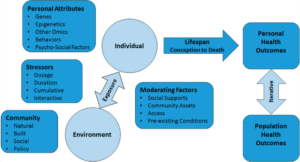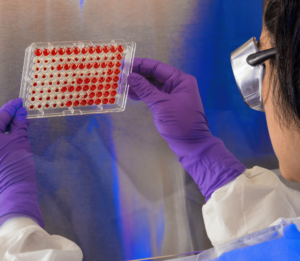Imagine your life as a long, detailed book. Each chapter records moments when your body interacted with the world around you – the air you breathe, the food you eat, the products you use. These interactions are not just fleeting moments; they accumulate into what scientists call the “exposome.” The exposome is the sum of all environmental exposures you’ve experienced in your lifetime and their impacts on your health. It’s a revolutionary concept that can help bridge the gap between genetics and environmental science, providing new insights into the causes of disease and the future of personalized health.
In this blog, we’ll explore what the exposome is, why it matters, the challenges in studying it, and how it could transform our understanding of health.
So What is the Exposome?
The exposome is like a health map built from all the exposures you encounter from conception onward. It encompasses everything from external exposures – like air pollution, dietary habits, and workplace hazards – to internal processes such as your body’s metabolic responses and patterns. By studying the exposome, scientists aim to unravel how these exposures interact with your genetics, physiology, and even epigenetics (changes in gene expression without altering the DNA sequence) to influence health.
The exposome is commonly divided into two main categories:
- Internal exposures: These include biological markers (biomarkers) that reflect your body’s responses to external exposures. Fields like genomics, metabonomics, and proteomics play a key role in analyzing these responses.
- External exposures: This category captures environmental and lifestyle factors such as air quality, chemical exposure, diet, stress, and even social determinants of health.
While the human genome allows us to map a pattern of our biological potential, the exposome provides context – showing how the environment sculpts that potential into reality.
Why Does the Exposome Matter?
For years, scientists have been fascinated by genetics as the ultimate key to understanding health. The Human Genome Project, for example, promised breakthroughs in disease prevention and treatment. However, it turns out that genetics alone accounts for only about 10% of diseases. This revelation has shifted the focus to environmental factors, which drive the remaining 90%.
Understanding the exposome is critical because:
- It reveals hidden health risks from seemingly ordinary exposures, like household chemicals or air pollution.
- It provides insight into disease pathways, showing how certain exposures lead to chronic conditions like asthma, diabetes, or cancer.
- It helps identify windows of vulnerability, such as how prenatal or childhood exposures can have lifelong consequences.
For example, exposure to lead during childhood is linked to cognitive deficiencies, while certain prenatal exposures, like thalidomide, have caused birth defects when occurring during specific developmental stages. By studying the exposome, scientists can pinpoint these critical periods and work toward minimizing harm.
Challenges in Studying the Exposome
Mapping the exposome is understandably a monumental task. Unlike the genome, which remains relatively stable over a person’s life, the exposome is highly dynamic and individualized. Here are some key challenges:
- Complexity and Variability
- The exposome changes over time and is influenced by numerous factors, including age, lifestyle, and geographic location.
- Different life stages bring unique vulnerabilities – what harms a fetus might not affect an adult the same way.
- Measuring Exposures
- Some exposures, such as short-lived chemicals, are transient and difficult to detect.
- Legacy biomarkers, such as antibodies produced in response to past exposures, offer clues but are not always available.
- Individual Differences
- Genetic and physiological differences mean that not everyone responds to the same exposure in the same way. For instance, some people can tolerate high levels of pollutants without apparent harm, while others develop diseases from lower levels of exposure.
- Data Complexity
- Exposomics relies on analyzing massive datasets from various sources. Integrating and standardizing this information remains a significant hurdle.

Despite these challenges, advances in technology and data science are helping researchers tackle these obstacles head-on.
Tools and Technologies Unlocking the Exposome
The exposome’s complexity demands new-age tools and techniques to decipher its mysteries. Here are some of the most promising approaches:
- Omics Technologies: Fields like metabonomics, lipidomics, and proteomics analyze molecular data to identify biological responses to exposures. These tools help link exposures to specific health outcomes and uncover disease mechanisms.
- Biomarkers: Biomarkers serve as measurable indicators of exposure and its effects on the body. For example:

- Legacy biomarkers: These can reveal past exposures, such as the presence of lead in bone tissue.
- Response biomarkers: These indicate how the body is reacting to a current exposure, such as elevated stress hormones due to air pollution.
- Exposure-Wide Association Studies (EWAS): Similar to genome-wide association studies (GWAS), EWAS analyze patterns of exposures across populations to identify links between environmental factors and diseases.
- Direct Reading Instruments and Surveys Instruments like wearable sensors and detailed questionnaires help measure external exposures in real time, providing richer data for analysis.
Real-World Applications of Exposomics
The practical implications of exposomics are vast and far-reaching. Here are some areas where it’s already making an impact:
- Public Health Policies
- By identifying harmful exposures, exposomics can guide regulations to reduce pollutants and other health risks. For instance, stricter air quality standards can reduce rates of asthma and cardiovascular disease.
- Personalized Health
- Understanding an individual’s exposome could lead to customized prevention strategies and treatments, improving outcomes for chronic diseases.
- Occupational Health
- Exposomics is helping researchers understand how workplace exposures contribute to diseases, enabling better protections for workers.
Ethical Considerations
As exciting as exposomics is, it raises important ethical questions. For example:
- How can we ensure that personal exposure data is kept private and secure?
- How should researchers handle findings that might stigmatize certain communities or lead to discrimination?
- What guidelines should govern the use of exposomics data in policymaking or insurance?

Discussions on ethical standards will be essential to ensure that the benefits of exposomics are realized without compromising individual rights.
The Future of Exposomics
The future of exposomics is hopeful, but it is a relatively new area of study and requires continued investment and innovation. Key priorities include:
- Developing Better Tools
- Improved sensors, biomarkers, and data analysis methods will make it easier to measure and interpret exposures.
- Collaboration
- Interdisciplinary partnerships between scientists, policymakers, and communities will be essential in turning exposomics insights into action.
- Education and Awareness
- Public understanding of the exposome can empower individuals to reduce harmful exposures and advocate for healthier environments.
Final Thoughts
The exposome represents a groundbreaking approach to understanding how the environment shapes our health. By capturing the intricate web of exposures over a lifetime, exposomics can uncover the root causes of diseases, improve prevention strategies, and guide healthier living for everyone. While complex challenges remain, the potential benefits of this field are massive – offering hope for a future where health is not just about genetic predispositions, but the choices we make and the environments we create.
Your health story is still being written each and every day. By embracing the insights of exposomics, we can work together to make those chapters healthier, happier, and more empowering for generations to come.









